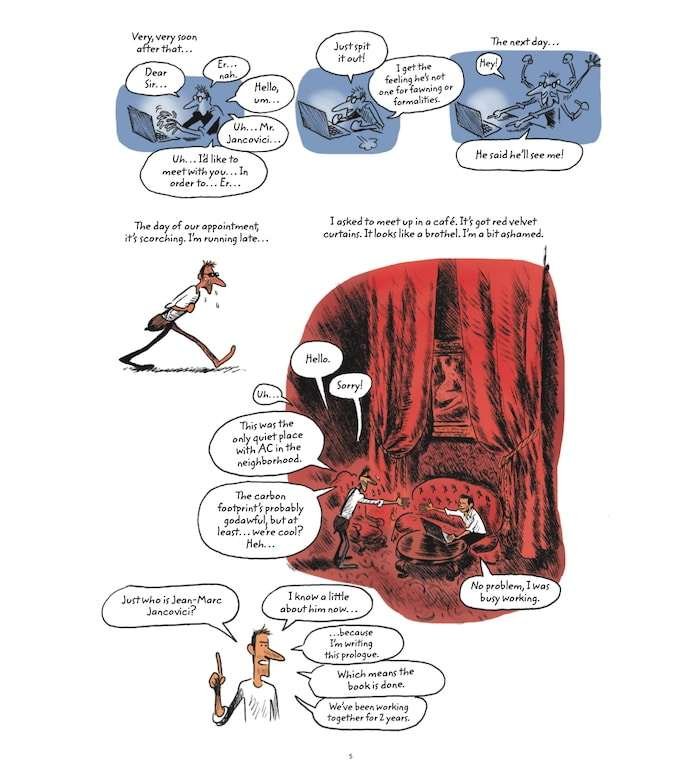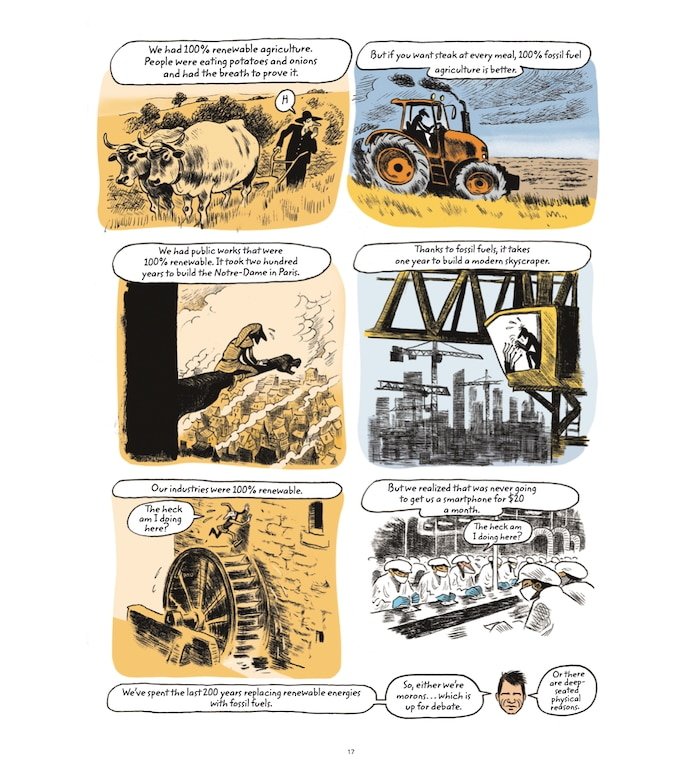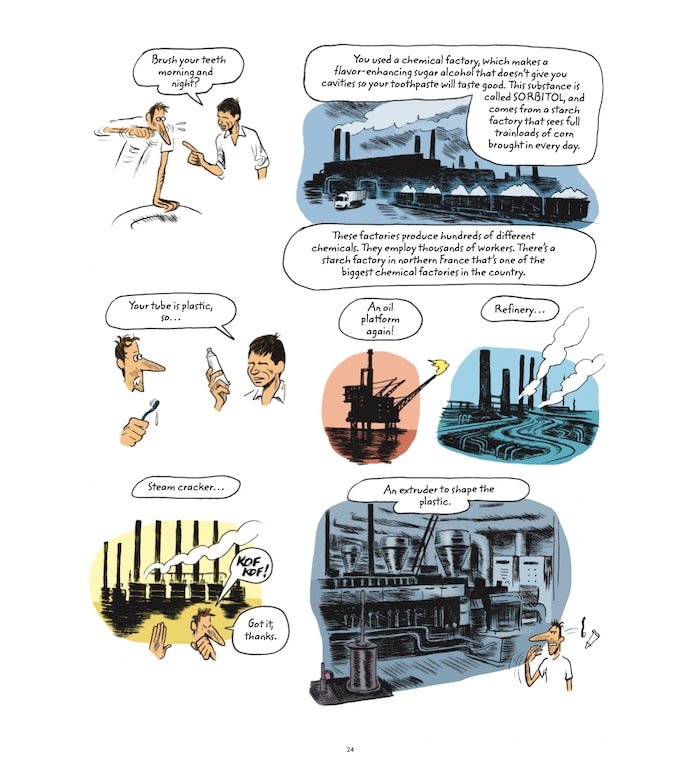Jean-Marc Jancovici is a well-known lecturer in France, and on YouTube, on the topics of energy and climate change. He focuses on the deep history and interconnections of the Earth’s consumption apparatus – how things are made, what things are made of, how energy is created, distributed and burned, and how the energy needs of the future should be met.
Christophe Blain is a French graphic artist known for his humorous historical works, most notably Weapons of Mass Diplomacy. But a few years ago, he was struck by current events in his home country.
“In the summer of 2018, there were severe heat waves,” Blain said. “I realized they were linked to global warming. I said to myself, ‘This is it, we’re here.’ I was very anxious for a year.”
He began talking to his brother to see what could be done. His brother had been following Jancovici’s lectures for more than ten years, and recommended that Blain watch a few and possibly make a connection with Jancovici.
“My brother told me, ‘Make an album (book) with Jean-Marc.’ I immediately replied, ‘I know. But it’s going to be hard.’ He said, ‘Do you have a choice?’ Five minutes later, I wrote an e-mail to Jean-Marc.”

The result of this meeting of minds is World Without End, a full-length graphic book that melds Jancovici’s words with Blain’s vibrant and comical illustrations to tell the story of energy: where we’ve been, and where we might be headed. It’s a long-form book version of one of his lectures, rich in data, theory and commentary, propelled by Blain’s unique method of visual storytelling in which a reader never gets lost or overwhelmed. The book has been a sensation in France, selling more than a million copies, and a translated version has been released in the U.S.
Blain shared some answers with EcoWatch via e-mail.
How and why did the book become so popular in France?
On social networks, I noticed that the people who followed Jean-Marc all wanted to pass on his thoughts and make him known. As if it were a vital necessity. I felt the same way.
I said to myself: a book is an object that’s easier to transmit than a conference. You can take your time to fully understand what’s at stake. What happened was exactly what I’d hoped: the people who read it wanted to give it away and pass it on.
How collaborative was the illustration / text process?
We’d meet up with Jean-Marc, and he’d use his courses, his conferences and the research he was doing with his company, Carbone 4. I’d ask him lots of questions, we’d comment on current events, and I’d take lots of notes. Then I’d work alone to transform my notes into a storyboard. We’d meet up again and correct my storyboard. Then we’d start again.
What kind of challenges were there illustrating the topic of energy, energy history and climate?
Jean-Marc is an extraordinary teacher. He uses lots of poetic, amusing images to explain sometimes complex concepts. If you don’t understand one image, he uses another. He always gets it right in the end. And everything becomes luminous. He makes you smart.

I love using images to explain sometimes abstract concepts. I do it a lot in my work. I love drawing crazy, poetic images, a bit psychedelic, to talk about something complex and subtle. Jean-Marc and I understand each other very well. We had a lot of fun together.
You choose visual “comedy” to move some sections forward – it helps to move through some quite depressing facts – how did you manage to juxtapose some of the bleaker facts with these kind of cartoony “jokes”?
Because I’m a funny guy. And I like to laugh at my anxieties. And because the book had to be fun. Always fluid, always hyper-understandable. This album is about serious, complex things. But I’ve worked very hard to make it easy to read.
As you were illustrating the book, what things did you learn?
I learned a lot from Jean-Marc’s own attitude. He’s been fighting this battle for years. His patience, energy and determination fascinate me. I’d often get angry at what I thought was idiotic behavior, in the face of the challenges facing all humanity. Jean-Marc brought me back to reason and patience, not to waste my energy in anger but to train my mind to find the right arguments.
What did you learn about the importance of energy?
I’ve learned that our way of life, even if we don’t see it, even if we don’t realize it, requires a colossal use of energy, of the Earth’s resources.
The details about the toothpaste tube and the smart phone, and the massive apparatus needed to create these ubiquitous objects… these were eye-opening to me. How did you feel learning that?
I felt that we live in a more fragile world than we think. That many details of our daily lives, which seem obvious and unchanging, can disappear faster than we think.

Was it surprising to you to see that “organic” is just a label that really has little impact on the deep underlying problems with the agricultural industry?
This is true for many other aspects. We live on heavy industry. A few organic beans are a good thing. But you have to look at the whole production chain, which produces for the masses, for millions of people, using colossal resources.
How was this book “therapy” for you? (On page 133, Blain talks about his recurring dreams of a nuclear accident.)
Jean-Marc told me that once you start looking into these problems, researching and working on them, you can’t stop. It’s a constant therapy through action. Understanding is the first and most important step. Even if you don’t know how to act right away. We change in spite of ourselves. We look at our surroundings differently. And then, little by little, we take action, in our daily lives or on a wider scale.
For example, we gradually stop wanting the same things. You organize your life differently. You have to accept that this is a step-by-step process. Not a radical revolution that will solve all problems.
Compared to your other work, how does World Without End fit in?
My vision of the world is different and I can’t go back. And I’m continuing to work with Jean-Marc.
Any other final words?
I sincerely hope to find an American audience who will welcome us. Not just because it would bring us success, but obviously because the USA has an extremely powerful influence on the world. I’ve traveled there several times. It’s a country that fascinates me.
The post Facing Climate Anxiety With Visual Comedy: ‘World Without End’ Graphic Artist Christophe Blain appeared first on EcoWatch.














